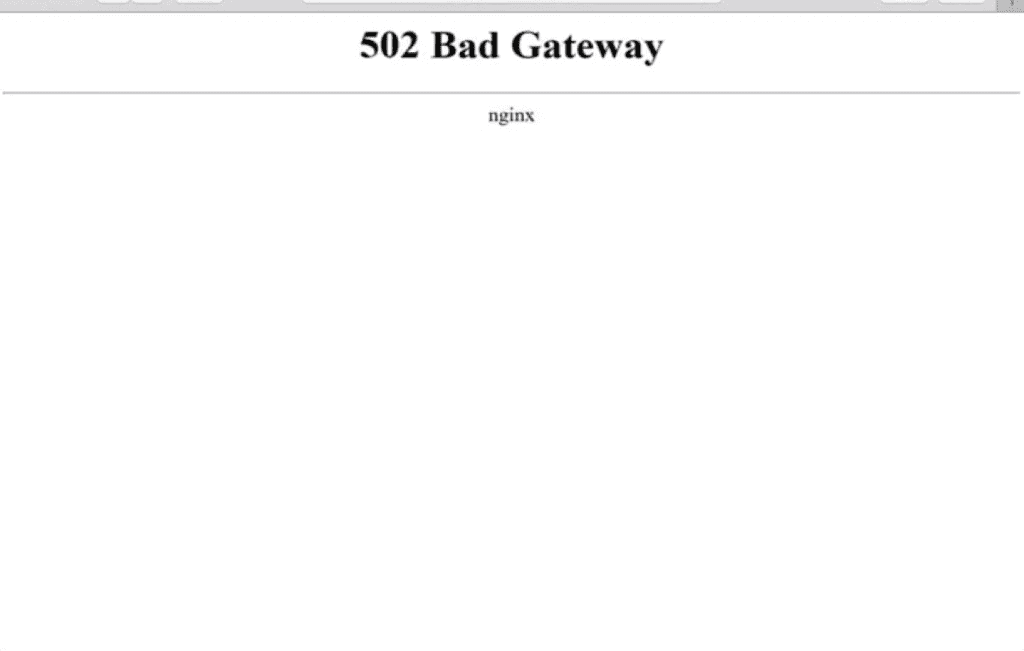502 Bad Gateway: What It Is
A 502 Bad Gateway is an HTTP status code that says: a server acting as a gateway or proxy got an invalid response from another server (the upstream server) it needed to complete the request.
That error means the fault is usually on the server side, but sometimes something in your network or configuration causes it.

A 429 error may appear the following ways depending on the root cause and browser:
- HTTP Error 502 – Bad Gateway
- 502 Service Temporarily Overloaded
- 502 Proxy Error
- A blank white screen
- 502 Server Error: The server encountered a temporary error and could not complete your request
- 502 Bad Gateway
- Error 502
- HTTP 502
- Bad Gateway: The proxy server received an invalid response from an upstream server
- Temporary Error (502)
- 502. That’s an error
- 502 bad gateway Cloudflare
Why You Should Care: SEO & Marketing Impact
- When your site returns 502 errors often, search engine bots (Google, Bing, etc.) can see it as instability. That can hurt crawling and indexing.
- Visitors hit broken pages; bounce rates rise. That harms user experience and can reduce trust.
- If error persists for hours, search engines might treat it as a site-level issue. Rankings can drop.
Common Causes
Here are frequent reasons you see 502 Bad Gateway errors. Knowing cause helps you fix it faster.
| Cause | What Happens |
|---|---|
| Upstream server crash or overload | The server that your proxy/gateway depends on is down, overloaded, or out of memory. |
| Timeouts | PHP or process takes too long; gateway gives up waiting. |
| DNS issues | Domain points to wrong server; DNS propagation problem; misconfigured DNS records. |
| Faulty code / bad plugin or theme (for CMS sites) | Malware, misconfigured plugin, or buggy theme triggers bad response. |
| Firewall, CDN, or proxy misconfiguration | The layer between client and origin server misbehaves. Firewall blocks, or CDN can’t connect correctly. |
| Browser / local network issue | Sometimes cached files, browser extensions, or local DNS cache cause you to see errors even if the server is fine. |
How You Fix It
You can resolve 502 errors through a mix of client-side checks and server-side fixes. Here’s a logical order to follow.
What You Do Immediately (Client-side checks)
- Refresh the page. Wait 30 seconds, reload. Sometimes traffic spikes or transient glitches cause 502.
- Try a different browser or Incognito / Private mode. If addons or cache cause issues, you may isolate them.
- Clear browser cache. Old or corrupted files can trigger bad gateway responses.
- Flush DNS on your local machine. Or try using a public DNS server (Google DNS etc.).
- Test from another device or network. If other people / devices see the site fine, the issue is likely local.
Server-side / Infrastructure Checks
- Check your hosting service status or contact your host. The problem may lie in upstream server or infrastructure.
- Examine server error logs (web server, PHP, etc.). Logs often show exactly what failed—timeout, missing file, or script crash.
- Disable recently added or updated plugins/themes. Often conflicts or bad code produce invalid responses. Roll back or deactivate to test.
- Check settings of your CDN / firewall / proxy. See if any rule blocks or misroutes requests. Temporarily disable to test.
- Increase timeout limits (PHP max_execution_time, proxy timeout, etc.). If processes take too long, they get killed, triggering 502.
- Restart services if possible (web server, PHP-FPM, cache, etc.). Sometimes stale processes or memory leaks cause failure.
Expert Insights
“A 502 Bad Gateway error shows that your gateway or proxy did its job—it just couldn’t get a valid response upstream.” — Developer Documentation, MDN developer.mozilla.org
“Often the quickest fix is locating the plugin or script with bad code or the host with resource constraints.”
SEO Best Practices to Limit Damage
- Set up custom error pages for 502 errors. That gives visitors guidance and can reduce bounce.
- Monitor your uptime. Use tools that alert you when 502 responses rise.
- Reduce plugin/theme bloat; optimize code so responses happen fast.
- Use reliable hosting with good capacity. Avoid shared hosting plans that easily overload.
- Keep your stack up to date (web server software, PHP, etc.) so you avoid bugs fixed in newer versions.
FAQ
Here are common questions with direct answers.
Sometimes yes. If issue stems from a temporary overload or transient network glitch, the error disappears after some minutes. But if it repeats, you must fix the underlying cause.
No. It signals an issue with server-to-server communication. Once you correct configs, update faulty code, or restore server capacity, error goes away.
Not necessarily. 502 arises mostly from server misconfiguration or overloaded upstreams. However, malicious code can trigger faults—but error alone doesn’t prove a hack.
If search engines see the site down for several hours (often more than 4-6 hours), they may deindex or lower rankings. Frequent or long outages hurt more.
CDN layers often show “502 Bad Gateway” with provider branding. Sometimes error is with the origin server, sometimes with CDN config. Check status pages of CDN and hosting.
You can reduce their frequency but not eliminate all risk. Use reliable infrastructure, minimize complex or slow scripts, monitor performance, and test after updates.




Leave a Reply